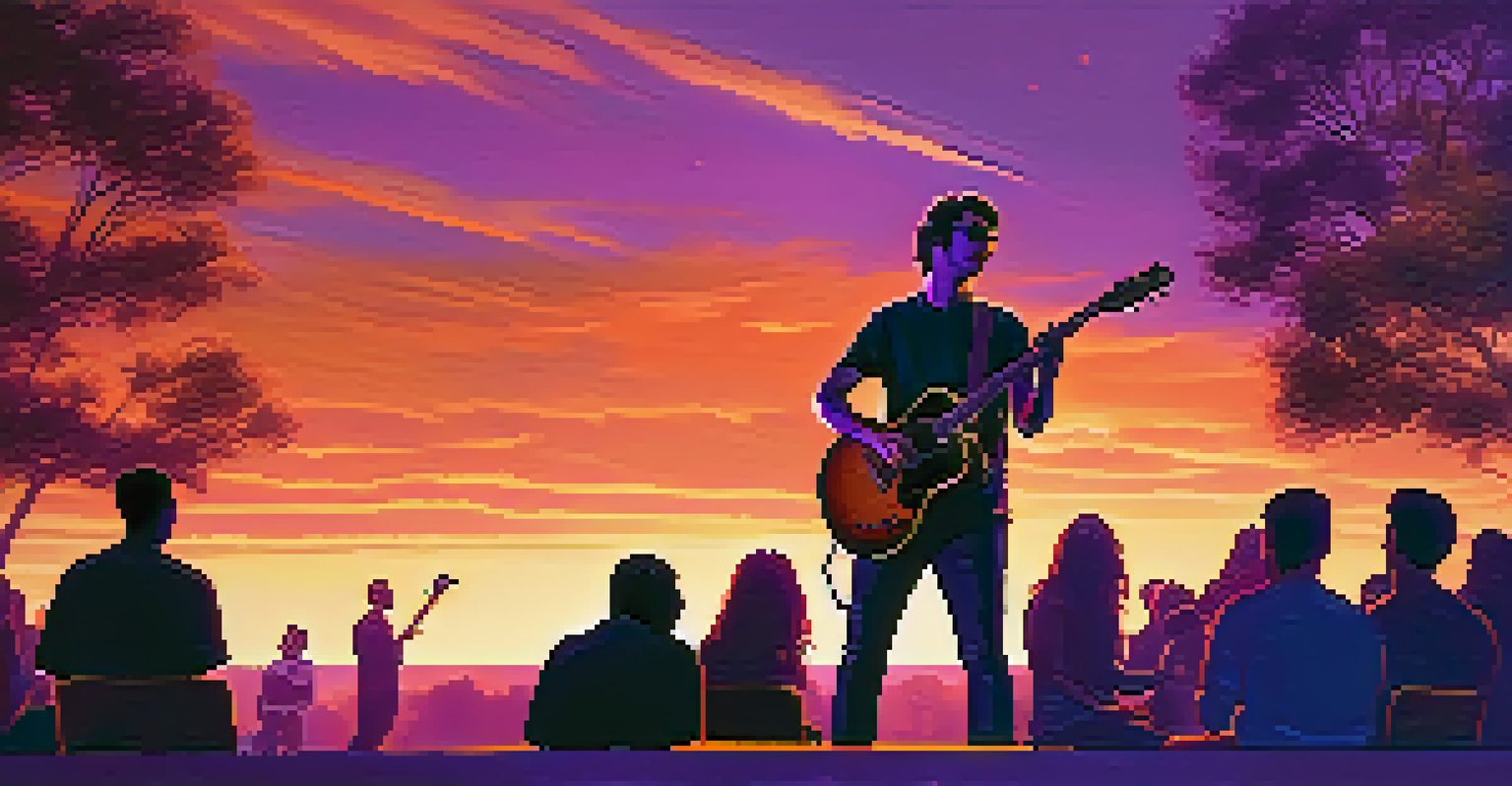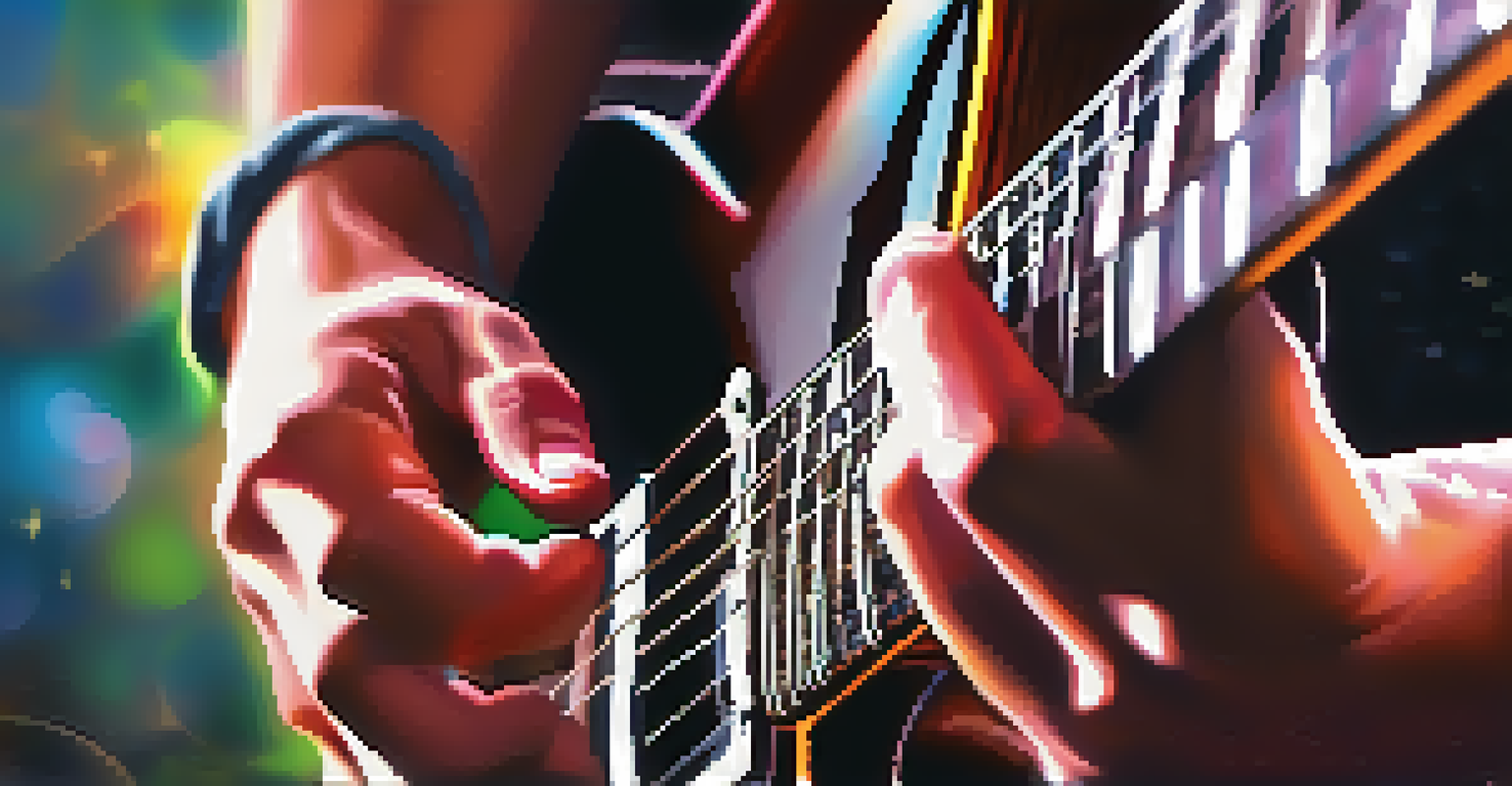Creating Emotion Through Guitar: Techniques for Artistry

Understanding the Emotional Power of Music
Music has an incredible ability to evoke emotions, and the guitar is a powerful tool in this emotional expression. Whether it's a soft, melancholic ballad or an energetic rock anthem, the guitar can convey a wide range of feelings. Understanding the emotional context of a piece can help you choose the right techniques to enhance that emotion. For example, a simple chord progression can carry profound feelings when played with the right dynamics and articulation.
Music can change the world because it can change people.
Think about how a single note can resonate with listeners. This is often achieved through techniques like bending or vibrato, which can make a note feel alive. Just as an actor uses their voice to express a character's emotions, a guitarist can manipulate sound to tell a story. By tapping into your own emotions while playing, you can create a genuine connection with your audience.
Ultimately, it's about capturing the essence of the moment. When you understand how to channel emotions through your guitar, each performance can become a unique experience. This emotional resonance is what sets great musicians apart from the rest, as they invite listeners into their world through sound.
Using Dynamics to Build Emotional Intensity
Dynamics, or the volume of your playing, play a crucial role in conveying emotion. A quiet, soft passage can create an intimate atmosphere, while a sudden loud section can evoke excitement or tension. Learning to control dynamics effectively allows you to guide your audience's emotional journey throughout a song. For instance, a gradual crescendo can build anticipation, leading to a powerful climax.

Incorporating techniques like palm muting or fingerstyle can also add depth to your dynamic range. By varying your touch on the strings, you can create contrasting textures that enhance the emotional impact of your music. Imagine playing a gentle lullaby that suddenly bursts into a loud, passionate section; the contrast can be breathtaking.
Emotional Power of Music
Music, especially through the guitar, can evoke a wide range of emotions, making each performance a unique experience.
Practicing your dynamics regularly can help you become more intentional in your playing. By focusing on how you express each note, you'll find new ways to connect with your audience. Remember, it's not just about hitting the right notes; it’s about conveying a feeling that resonates long after the last chord.
The Role of Phrasing in Emotional Expression
Phrasing refers to how you articulate a musical idea, akin to how a speaker emphasizes words in a sentence. Effective phrasing can make a melody feel more expressive and relatable. For example, a well-placed pause can create a moment of reflection, allowing listeners to absorb the emotion before moving on. This technique can be especially powerful in solos or lyrical passages.
The beautiful thing about music is that it transcends language.
Consider how a singer might elongate a note to convey longing or heartbreak. As a guitarist, you can mimic this by stretching out certain notes or using techniques like slides and hammer-ons. This not only adds a personal touch but also invites listeners to feel the emotion behind your playing.
Ultimately, phrasing is about storytelling. Each phrase should lead naturally into the next, creating a narrative that captivates your audience. By paying attention to how you shape each musical idea, you can transform a simple melody into an emotional journey.
Incorporating Techniques for Emotional Depth
Various guitar techniques can enhance the emotional depth of your playing. Techniques like fingerpicking, tremolo, and harmonics can introduce unique textures that evoke different feelings. For instance, fingerpicking often creates a gentle, flowing sound that can feel soothing and introspective. On the other hand, using harmonics can add an ethereal quality, enhancing the dreamlike quality of a piece.
Experimenting with different techniques can help you discover what resonates most with you and your audience. It’s like having a toolbox of emotions at your fingertips. By combining these techniques with your own style, you can create moments that truly move your listeners.
Dynamics Enhance Emotion
Controlling dynamics in your playing can guide the audience's emotional journey and create powerful contrasts.
Remember, the goal is not to showcase technical prowess but to connect emotionally. Each technique should serve the song, enhancing its emotional landscape rather than overshadowing it. With practice, you can learn to weave these techniques seamlessly into your playing.
Exploring Different Genres for Emotional Diversity
Different musical genres can evoke distinct emotions, and exploring various styles can enrich your emotional expression. For example, blues often conveys feelings of sorrow and longing, while folk music may evoke nostalgia and warmth. By immersing yourself in different genres, you can learn new techniques and approaches to expressing emotion through your guitar.
Consider how a jazz guitarist might use improvisation to convey spontaneity and joy. In contrast, classical guitarists often focus on precision and nuance to evoke a sense of grace. By absorbing the nuances of different styles, you can expand your emotional vocabulary as a musician.
This genre exploration can also inspire your original compositions. Mixing elements from various styles can create a unique sound that reflects your emotional experiences. The beauty of music lies in its diversity, and embracing that can lead to more profound emotional connections with your audience.
Connecting with Your Audience Through Performance
When performing, your connection with the audience can significantly impact the emotional experience. Engaging with listeners through eye contact, body language, and energy helps create a shared emotional space. Imagine playing in a coffee shop; the more you engage with your audience, the more they’ll feel the emotion behind your performance.
Consider the atmosphere of the venue as well. A small, intimate setting allows for a different emotional connection compared to a large concert hall. Adjusting your approach based on the audience and environment can enhance the emotional impact of your music. For instance, performing a soft ballad in a quiet room invites introspection, while a loud anthem in a packed venue can fuel excitement.
Authenticity Matters in Music
Being authentic and vulnerable in your performance allows for deeper connections with your audience.
Ultimately, your performance should invite listeners into your emotional world. By fostering this connection, you can create memorable experiences that resonate long after the music stops. Remember, it’s not just about playing the notes; it’s about sharing a piece of your heart.
The Importance of Authenticity in Emotional Music
Authenticity is key when it comes to expressing emotion through your guitar. Playing from a place of genuine feeling allows your audience to connect on a deeper level. Whether you’re conveying joy, sadness, or anger, being true to your emotions will resonate with listeners. Think about your favorite songs; often, it’s the raw emotion that draws you in.
Being authentic also means being vulnerable. Sharing personal experiences through your music can create a powerful connection with your audience. It's like telling a friend about a meaningful moment in your life; the more genuine you are, the more they will relate. This vulnerability can transform a simple song into a profound experience.

Remember, everyone experiences emotions differently. Your unique perspective and emotional journey can inspire others and create a sense of community through music. Embrace your authenticity, and let it shine through in your guitar playing.